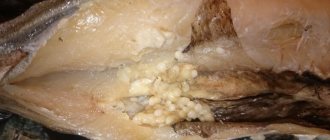Reasons why garlic turns blue and green when pickling, salting, frying, stewing vegetables and mushrooms. Are blue or green onions dangerous?
Very often we come across a strange phenomenon - when garlic begins to turn green or blue during the process of salting, pickling, or preservation. The same thing happens with stagnant preserves - through the glass you can see blue-green, floating cloves of garlic. Some housewives prefer to get rid of “spoiled cans,” and some are wary of taking samples from strange preserves.
As for pickled or salted mushrooms, if they contain blue or green garlic, everyone comes to only one conclusion - the mushrooms contain poison.
This article will be designed to destroy all existing myths and explain the reason for the pigmentation of garlic during canning or pickling of various products.
Why did the garlic turn blue and green in pickled tomatoes, mushrooms, cucumbers: reasons
The problem that concerns the change in the shade of garlic cloves during marinating has received a huge amount of attention and no less time. Scientists were able to conduct research that explained this unusual phenomenon.
During scientific work, they found out that when the integrity of garlic is disrupted, its components react. For example, alinase begins to destroy allyl sulfide cysteine sulfoxide. As a result, the essential oil breaks down, which triggers the formation of sulfates and sulfides.
Garlic color change
From one part of these compounds a large amount of thiol, ammonia, and pyruvic acid is formed. The second part begins to release special pigments responsible for such an interesting color of garlic.
You may be wondering why not every garlic changes. The answer to this question is very simple - many factors can influence the chance of staining and its intensity.
For example, where the garlic was grown, how it was stored, how ripe it was at the time of harvest. In addition, pigment paint begins to appear more actively at a certain temperature and acidity.
- Alliin decomposes much faster when the component is exposed to high temperatures, starting from 40 degrees to 80.
- Blue and green pigment begins to be released in a not very acidic environment if amino acids are present.
- Garlic, which was grown in southern countries, contains a lot of allyl sulfide cystene sulfoxide. The same cannot be said about garlic, which is grown in northern countries. Consequently, the “southern” garlic is colored much more actively than the “northern” product.
- Young garlic that has only recently been harvested may also contain alliin. But despite this, its coloring will be slower than that of yellowed garlic.
- If garlic is stored in a room at a temperature of 19-24 degrees, then less alliin will accumulate in the cloves than when stored in a cool place.
- If garlic is first stored in a cool room and then in a warm room, the amount of alliin in the cloves can be significantly reduced.
Let's sum it up
Now you know why garlic turns green or blue during cooking. Almost any garlic changes color if you damage the shell of the clove or cut it. The degree of color change depends on the place of cultivation (southern or northern region) and the time of ripening (young or mature).
However, with a change in color, the product does not become harmful or dangerous to human health. Therefore, it can be safely added to various dishes and stored for the winter.
Elena Malysheva about garlic
Why did garlic turn blue and green when salting lard on food: reasons
Very often, many housewives observe such an interesting process - the garlic begins to change color very intensively. This often happens for the following reasons:
- Due to improper storage of the main product - salted lard.
- Due to the fact that tissue damage to the garlic cloves occurs.
In order to avoid garlic not changing its natural color, it is advisable to use only large cloves, and store salted lard exclusively in a cool place.
Changing the color of garlic in lard
Garlic also often changes color if it is added to hot food. In such situations, the pigmentation of a given vegetable product can be justified as follows: high temperature, which affects garlic, violates its integrity, plus is a temporary indicator. The longer crushed or chopped garlic is in hot food, the more likely it is to color.
Cooking tricks
To make food look more aesthetically pleasing (without green or blue spots of garlic), housewives use the following culinary “life hacks”:
- Only young garlic is used in cooking;
- when marinating or salting, peel the slices with your fingers;
- The teeth are pickled exclusively in a cold way, the marinade is not subjected to heat treatment;
- keep the preserves cool;
- dried garlic is added to hot dishes;
- fresh garlic is added when frying or baking at the very end of cooking.
Why did garlic turn blue and green when baking or frying: reasons
- During frying or baking, two main factors begin to influence the garlic, which cause pigmentation of all or some cloves.
- The first influencing factor is that the same violation of the integrity of a given vegetable crop occurs. As a rule, we use chopped garlic with a knife or squeezed out in a press when preparing a particular dish. Due to the fact that the shell of the teeth is damaged, the rapid decomposition of alliin begins.
- The second influencing factor is elevated temperature, which is usually present in a heated frying pan or saucepan. High temperature during cooking (baking, frying) is also considered one of those conditions due to which the rapid decomposition of allyl sulfide cysteine sulfoxide occurs.
How to avoid this?
So, we found out why garlic turns green during heat treatment. What to do about it? Many housewives are afraid of such garlic, although there is nothing harmful in it.
But to avoid discoloration of the crop, you need to follow some rules.
- Fewer substances that are responsible for pigmentation are contained in young and freshly harvested crops.
- It is best to store the product in a warm room, because... at temperatures from 0 to +5 degrees, garlic begins to turn green faster.
- To slow down the change in pigmentation, the plant must first be blanched for a few minutes.
- It is best to peel it with your hands so as not to damage the skin. Any cut provokes the work of substances responsible for pigmentation.
- When preparing a hot dish that uses ground or crushed garlic, the product must first be dried or fried.
- The plant should be salted and pickled only in a cold way.
- Store all preparations in a cold room.
- Garlic is served separately from hot dishes.
Is it possible to eat blue or green garlic?
In those southern countries where garlic is grown in huge quantities, people do not even notice that it changes color. This process is normal. Therefore, you don’t have to worry about this either.
Neither garlic that has turned green nor teeth that have turned blue when cooking, preserving or salting will cause harm or danger to the human body. Therefore, never fill your own head with such inventions. Try to enjoy the dishes you love so much with great pleasure!
Using imported garlic in preservation
We offer you preservation recipes during which garlic never changes color:
Recipe 1:
To prepare, stock up on:
- Cucumbers – 4 kg
- Parsley – 2 bunches
- Vegetable oil – 200 ml
- Vinegar – 200 ml
- Sugar – 180 g
- Garlic – 16 tooth
- Salt – 120 g
Cooking process:
- Wash the cucumbers and cut into slices. Place in a saucepan.
- Chop the parsley. Send to cucumbers.
- Pour in oil and vinegar. Add spices.
- Divide the garlic lengthwise to form cloves. Add to other ingredients.
- Leave the components for 6 hours.
- Then put them in jars and fill them with marinade.
- Sterilize for 25 minutes.
- Roll it up.
Changing the color of imported garlic in canning
Recipe 2:
For the recipe, stock up on:
- Sweet pepper – 2.5 kg
- Water – 100 ml
- Oil – 200 ml
- Salt – 45 g
- Sugar – 100 g
- Vinegar – 100 ml
- Black pepper, allspice
- Garlic – 2 goals
Cooking process:
- Peel the pepper and cut into pieces.
- Peel the garlic. Make sure it is not damaged.
- Boil water in a saucepan, add pepper, simmer for 4 minutes. Drain the water and place the peppers on a plate to cool.
- Add oil and spices to the water. Boil, add pepper again and cook for 4 minutes. Remove the pepper and set aside to cool.
- Add garlic to the marinade and simmer for 2 minutes.
- Place garlic, hot pepper and allspice into a clean jar.
- Add sweet pepper.
- Boil the marinade and pour it into jars with pepper.
- Roll it up.
What to do to avoid garlic turning blue
Following simple recommendations will allow you to get, when preserving, appetizing slices of a regular color:
- Use young garlic that has not reached full ripeness for pickling.
- Marinate the cloves whole - do not cut even large slices - contact with a knife increases the likelihood of discoloration.
- When preparing, cold marinades are preferable; under the influence of boiling water, the release of alliin increases.
- Long-term storage of vegetables before harvesting also contributes to the accumulation of the substance in the product, especially if it was stored in a cool warehouse.
- Use “local” garlic for winter preparations; prepare it immediately after harvesting.
- It is better to clean it for preparations for the winter with your hands - with a knife you can break the integrity of the slice. It is possible to marinate it with whole heads, rinsing them well and leaving a little peel at the bottom.
A young vegetable in a jar with tomatoes, cucumbers and, as an independent preparation, will remain beautiful and retain its usual color.
Choosing the right garlic
The easiest way to avoid turning blue cloves of garlic is to choose young heads that have not had time to become covered with a dense husk. Such a vegetable can be pickled without disassembling it into slices, just by slightly peeling it (removing the top layer of peel); beets are often added to such preparations.
Pickled green garlic arrows are very tasty. They are eaten as a separate dish or added to various salads. Jars of pickled young garlic cloves are eaten very quickly; all family members love this snack.
The color changes in a canned product that has stagnated on a basement shelf. In addition, if the marinade contains enough vinegar, the cloves will not turn blue.
When purchasing, you should choose dense, undamaged heads. Small garlic has a more refined taste and aroma, so you should not choose too large specimens. You should not buy already sprouted vegetables for winter preparations.
See also
11 quick and delicious recipes for pickling squash for the winter will lick your fingers
Read
The scientific world claims
Scientists have gotten to the bottom of this process; copper is involved in it.
Garlic cloves may change color during canning if their integrity is compromised:
- Essential oil and enzyme are released from the tissues.
- Under the influence of the enzyme, a chemical reaction is triggered, which leads to the destruction of alliin.
- Essential oil particles are released, which immediately react with amino acids.
- A characteristic bluish-greenish pigment appears. This is what stains the teeth.
Is it possible to eat it?
As it becomes clear, none of the reasons affects the quality of conservation. The color change does not affect the taste of pickled garlic. A blue product is safe for health; it can only slightly spoil the appearance of the vegetable. Therefore, pickled garlic that has changed color can be eaten completely calmly . It is aromatic, it is healthy and it is tasty, not only as an addition to the main dish, but also as an independent ingredient.
How do spices and seasonings affect color change?
Some spices and seasonings used for pickling can cause the appearance of a blue-green, dark gray hue. Similar phenomena tend to occur when adding to preservation:
- cinnamon;
- carnations;
- ground black pepper.
Mixtures consisting of several varieties of spices, seasonings, and spicy vegetables can affect the color of a vegetable. In such cases, a chemical process occurs consisting of the interaction of various ingredients of the dish.
It is important to understand that herbal spices and seasonings contain natural coloring substances that are not dangerous to humans.
Why does garlic change color?
Garlic sometimes changes color after preservation or even during its preparation, for example, in a salad - it turns blue or green. In fact, there is nothing dangerous in such a product, although doubts still arise when looking at it.
The popular version says that only Chinese garlic turns blue or green, but this is absolutely not true. Any fruit can change color, even if grown in your own garden and even if it is preserved correctly.
Another popular version of the change in color of canned garlic is the copper it contains. According to “experts,” it reacts with vinegar and gives such an unusual color. But this theory is shattered to smithereens, because the vegetable turns blue arbitrarily. Even in one batch of blanks at home, some may turn green, but some remain their natural color.
How to cook: step-by-step instructions
- Sort and wash vegetables and herbs. Choose small cucumbers (gherkins are fine). Take a young head of garlic - clean it of dry scales, but do not separate it into cloves. This way, the beneficial phytoncidal substances of the vegetable will be preserved to a greater extent.
- Rinse and sterilize the jar and lid with boiling water or boiling steam. You can do this like this: pour boiling water into a jar that has been washed with warm water, after 2-3 minutes, pour it out and fill the jar. Keep the lid in a saucepan of boiling water until the appetizer is sealed.
- Place the garlic and cucumbers tightly into the jar. Place dill and horseradish on top.
- Add aspirin and salt.
- Pour the prepared boiling water over the vegetables and immediately preserve with a lid.
- Set aside to cool at normal room temperature. Then go down to the basement or cellar. Do not store the workpiece in a warm place.
https://www.youtube.com/watch?v=DEFEnLfh1gM
Are you still wondering why garlic turns blue when pickled? Proper processing of the vegetable and preservation, its storage in a cool room will not allow this!
Tags: preservation, why, turn blue, garlic
History of origin
Until the 50s of the 20th century, there were no special questions about the blueness of garlic - probably because each housewife had her own tricks for preparing it. But in the 50s, industrial garlic preservation was launched in America, and problems began. Large batches of products were rejected due to blue discoloration, and the industry suffered serious losses because of this. At that time, garlic began to be prepared in the form of puree, which was then preserved. The cloves were crushed, the resulting paste was mixed with salt and vinegar, and then rolled into containers. The situation required a study, for which biochemists were involved.
Biochemists say...
The scientific basis for the blueness of garlic in a vinegar marinade is as follows: the color transformations of garlic during the canning process are due to the release of essential oil components and enzymes as a result of the destruction of vegetable tissue. A representative of the latter, alinases, leads to the decomposition of alliin, which entails the process of dividing essential oils into sulfates and sulfides.
- thiol, ammonia and pyruvic acid - as a result, garlic acquires an unpleasant odor;
- pigments that give garlic its blue-green color.
What does this mean for the average cook?
Specifics of Chinese garlic
Experienced housewives have probably noticed that the spicy vegetable began to change color intensively only in recent years.
This is due to the fact that instead of our “native” product, we switched to garlic from China, the world’s largest producer today. But there is no need to immediately blame the farmers of the Middle Kingdom for dishonesty. Their garlic is not a genetic modification or the result of excessive use of chemicals. It’s just that this medicinal vegetable, grown in the southern regions, including East Asia, is much richer in alliin than its northern “brother.” It is not surprising that garlic collected from our summer cottages or bought from grandmothers at the market changes color extremely rarely, unlike the Chinese garlic that fills supermarkets.
In addition, southern garlic is fully ripe at the time of harvest, while we harvest it slightly unripe.
However, based on the fact that it is alliin that initiates the formation of allicin, a substance with the strongest anti-cancer, immunostimulating and bactericidal properties, we can conclude that Chinese garlic is more beneficial than ours. Although the conditions for growing the product are very important here.
Bottom line: there is no need to be afraid of Chinese garlic; in any case, as it turns blue or green, it does not become worse or more dangerous.
Times change, and with them, products familiar to us from childhood acquire different properties. Fortunately, new does not mean worse, as is the case with garlic. But if you want to avoid pigmentation of this vegetable, this is not at all difficult to do, observing the correct storage and processing conditions.
Factors that accelerate the reaction
In what cases are you more likely to get an exotic color:
- Blue and green discoloration occurs more actively at a certain temperature (+45, +80 degrees) and environment (slightly acidic).
- The amount of alliin is influenced by the zone in which the crop grew. The warmer it is, the more it is.
- Ripe fruit contains more alliin than young fruit.
- The concentration of the compound increases during storage, and the colder it is, the more intensively it is produced.
Copper, iron, aluminum, chromium and other metals do not have any effect on the greening of canned garlic.
Common Theory
Why does homemade garlic turn blue when preserved and processed? The version considered by everyone is that this product contains a certain amount of ordinary copper. In certain cases, copper enters an acidic environment, which causes an acute reaction. After this, a fairly global change in the shade of garlic occurs. This reaction can be expected with ordinary vinegar, which is present in almost all recipes for pickling and preserving foods.
Blue garlic with pickled cucumbers
There is a theory that the amount of copper in garlic directly depends on certain factors: variety, cultivation, soil, degree of ripening of the bulb, use of fertilizer, area of growth.
Scientists' version
What do experts say on this issue? There is a whole theory that was put forward by chemists, and also confirmed by a variety of studies and experiments. When the integrity of the lobules is compromised, the following gradually begin to emerge from tissues damaged by processing:
- essential thick oil;
- enzymes.
Under the influence of a special enzyme, an active chemical reaction immediately begins, which gradually leads to the destruction of alliin, which provokes the formation of essential oil particles. Then the new element begins to react to the amino acids of the product and creates certain shades - blue, green, green-blue. Then the lobules are stained evenly or partially.
Shades of garlic can range from yellow to green and dark blue
Why else does garlic turn blue? There are several factors that indicate a direct influence on the course of all reactions: the process is significantly accelerated and reacts to the presence of amino acids in the case of an ambient temperature of 45-80 degrees.
The degree of brightness of the pigment shade and the intensity of its formation almost does not depend on the selected variety of garlic. But it directly depends on the growing conditions, the stage of ripening at the time of harvesting, and its further storage. That’s why garlic turns blue unpredictably – the process cannot be predicted.
Garlic may also turn blue during storage.
Scientists were able to establish that all the minerals that each lobe includes: copper, iron, manganese, aluminum, zinc or chromium do not affect this chemical reaction. We can conclude that all the elements from the chemical table are not able to directly affect the degree of blueness of garlic in the marinade.
Blue garlic in a jar with canned cucumbers
We can conclude that absolutely any garlic can change its color, which does not depend in any way on the country of origin or the variety itself.
The main task is proper storage, consumption, use and preparation.
Why garlic begins to change color has become more clear. How to avoid this effect in order to reduce the likelihood of garlic cloves turning blue?
Turning blue just in air for 24 hours - experiment
Rules
It is required to process the product correctly, then you reduce the risk of changing the shade of this product:
- A young root vegetable, which contains little alliin, healthy proteins and various volatile compounds, but a lot of high concentration sugars, when pickled or salted, almost never changes its hue to green or blue. For the pickling recipe, it is better to purchase an immature and young product and collect it from home garden beds in advance. It is also known that young heads turn out much tastier and juicier in their finished form.
- It is recommended to use a still young and almost ripened product when preserving homemade or purchased zucchini, cucumbers or squash.
- When preparing any marinade recipe, do not damage the garlic cloves, so do not use sharp knives, but do everything with your hands.
- The fruit should be added to the prepared dish at the end of the process, or even better, just before serving the food.
- Use already dried garlic in cooking, then you will not have any unpleasant tint effect on the cloves.
- To effectively and efficiently avoid tinted spots on garlic, you do not need to immediately add them to marinades or preserves with mushrooms. It is recommended to chop and add pieces of garlic to ready-cooked mushrooms just before serving them to guests or family.
Canned garlic does not always turn blue
If you follow all the rules and tips, you can avoid changes in the color changes of the slices. The judicious use of garlic will help transform the dish and its taste. It may also happen that the fruit eventually turns blue or green, since no one is immune from this, but you will minimize the risk of changing canned or fermented garlic in your original and tasty recipes.
Watch this video on YouTube











